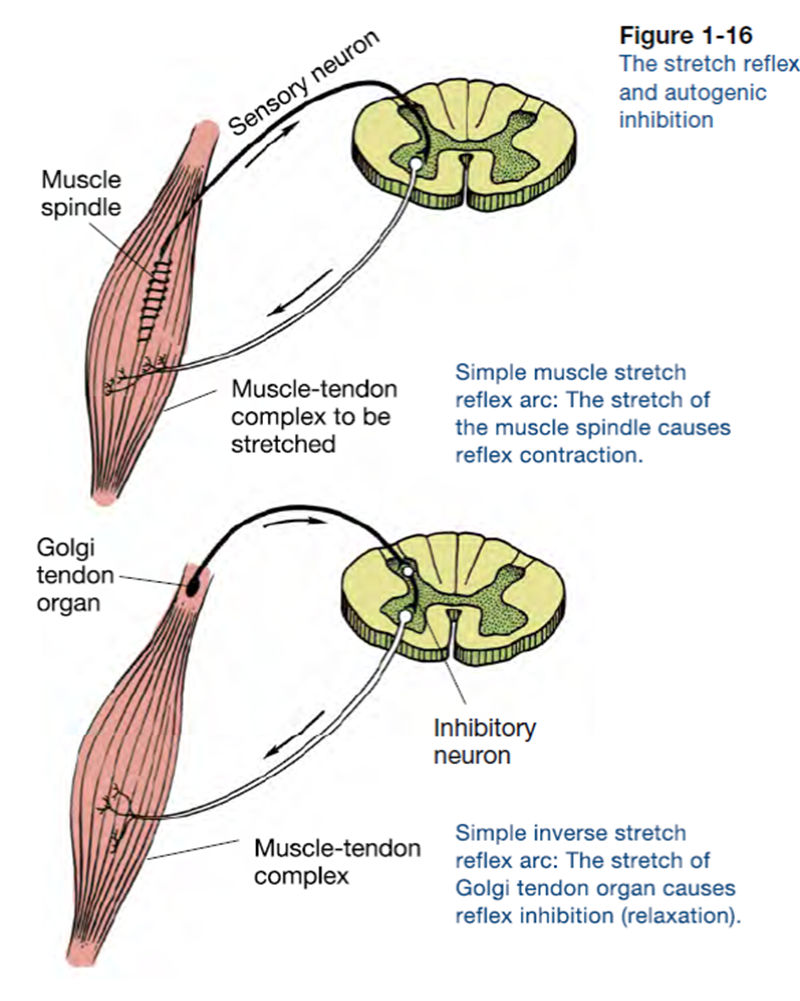To keep muscles safe and healthy, we need to have a good understanding of the body’s most basic underlying structural components and how they work together, as this knowledge provides the foundation for effective exercise instruction. Two of these components—Golgi tendon organ (GTO) and muscle spindle—belong to the nervous system and function to influence movement.
Two important proprioceptors that play a role in flexibility, the GTO and muscle spindle work together reflexively to regulate muscle stiffness. When a GTO is stimulated, it causes its associated muscle to relax by interrupting its contraction. When a muscle is inhibited by a GTO, the process is called autogenic inhibition. The function of the GTO can be considered opposite of the muscle spindle, which serves to produce muscle contraction.

Imagine a muscle spindle as if it were a thread spiraled (or wrapped around) muscle fibers near the muscle belly; as the muscle lengthens or stretches, it pulls on the spindle causing it to lose its spiral shape and also stretch. This signals the muscle to contract (after which, the spiral regains its shape), in turn protecting the muscle from being overstretched. This process is called the stretch reflex.
When a muscle spindle’s associated muscle is rapidly stretched, the spindle can cause two things to happen: (1) it may signal its muscle to contract to prevent it from going too far, too quickly in the stretch; and (2) it can inhibit the opposing muscle (the antagonist to the muscle being stretched) to prevent it from contracting so that it can’t contribute to any further stretching. The relaxation of the antagonist that occurs simultaneously when a muscle spindle’s contraction of its associated muscle occurs is called reciprocal inhibition. Ultimately, the muscle spindle functions to alert the brain that nearby joints and soft tissues are in danger of being stretched too far. These are important concepts in understanding body awareness (also known as proprioception and kinesthetic awareness).
GTOs sense muscular tension within muscles when they contract or are stretched. When the GTO is activated during contraction, it causes inhibition of the contraction (autogenic inhibition), which is an automatic reflex. When the GTO is activated during stretching, it inhibits muscle spindle activity within the working muscle (agonist) so a deeper stretch can be achieved. GTOs are sensitive to changes in tension and rate of tension and, because they are located in the musculotendinous junctions, they are responsible for sending information to the brain as soon as they sense an overload. Static stretching is one example of how muscle tension signals a GTO response. So, when you hold a low-force stretch for more than seven seconds, the increase in muscle tension activates the GTO, which temporarily inhibits muscle spindle activity (thus reducing tension in the muscle), and allows for further stretching.
It’s also worth mentioning that autogenic inhibition can be induced by contracting a muscle right before it is passively stretched, which is a method called proprioceptive neuromuscular facilitation (PNF). PNF is a stretching practice that promotes the response of neuromuscular mechanisms through the stimulation of proprioceptors in an attempt to gain more stretch in a muscle. A practical example of this method is to produce a low-grade (50% of maximum force) contraction within a muscle for six to 15 seconds immediately before having a partner passively stretch the muscle. The pre-stretch contraction reduces muscle spindle activity within its associated muscle (the muscle that is about to be stretched) so that the brain more willingly accepts an increase in range of motion during the impending stretch.
The muscle spindles and GTOs go through this cycle to help you stretch safely and effectively. This is also the reasoning behind holding a stretch for seven to 10 seconds to allow the stretch to deepen. GTOs and muscle spindles work together through their reflexive actions to prevent injury.
If you are a visual learner, feel free to refer to outside credible sources, such as YouTube videos, to get further clarification on this topic.
 by
by 







 by
by